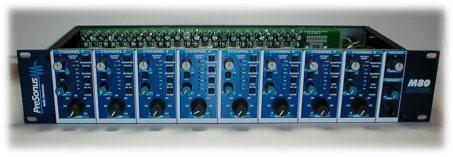
Forward
This page describes the steps necessary to remove and replace the input transformers found in a Presonus model M80 eight channel microphone preamplifier. Since the circuitry for the two channel model MP20 is for the most part identical to the M80, much of the information presented here should be useful and relevant for that model too.
The original transformer used in both the M80 and MP20 was made by Jensen Transformers and was model JT-11K8-APC ( from here on referred to simply as a 'Jensen' ) The transformer currently used is of unknown manufacture and is found in units that were made around the beginning of the year 2000 to date. ( from here on referred to simply as a 'generic' )
Both transformers are enclosed in cylindrical metal packaging that is approximately 1" tall and 1" in diameter and have eight pins on the bottom in two parallel rows of four pins each. A pin 1 indicator dot is printed on the top to ensure correct installation. The Jensen's are also clearly marked on the top with the Jensen logo, part number, country of manufacture and manufacturing lot number. The generic's have no markings other than the pin 1 indicator dot and are slightly bigger in diameter than the Jensen's. Also the construction of the bottom is slightly different between the two with the Jensen's having a more complete method of case insulation.
|
|
It is important to realize that even though the steps to swap transformers are simple and few, this is not a project for beginners or those without specialized soldering tools and skills. Desoldering a component from a double sided and hole plated through circuit board, especially one that you can only access from one side like these transformers, is not an easy task without the proper tools and is a job best left to an experienced tech. This page is here only as an aid for those who are going to attempt the transformer replacement and a fair degree of mechanical aptitude, soldering technique, electronics repair experience and patience is assumed.
At the bottom of this page are three links that will take you to the various stages of my comparison experience. The first is 'The Overview' and will explain the circumstances that led to changing transformers in the first place. The second link is 'The Listening Tests' and will allow you to make up your own mind which transformer you prefer on a variety of sound sources. The third is a short discussion of what my conclusions and opinions are about the tests.
I sincerely hope that you will find this site interesting, if not useful, and I'm open to any comments or suggestions you might be willing to share.
Best of luck!
Tools
| Tool | Notes |
| cross-slot screw drivers | for removing and attaching chassis top and XLR screws |
| 12mm nut driver | for for removing and attaching ¼" jack 'nuts' |
| soft rubber mallet |
for loosening XLR connectors if needed |
| desoldering iron |
for removing transformers from circuit board |
| desoldering braid | for removing transformers from circuit board |
| soldering iron | for attaching transformer to circuit board |
| electronics grade solder | for attaching transformer to circuit board |
| defluxing aids | for removing excess flux from circuit board after soldering |
| misc. | needle nose pliers, magnifying glass, small bright flashlight |
Instructions
| An explanation of the circumstances that led to changing transformers and conducting listening tests. |
| Audio samples in MP3 and WAV formats for comparing the sound of the two transformers. |
| My conclusions and opinions about the testing. |
| What Other People Think |
| Tests, modifications and opinions of others. |













